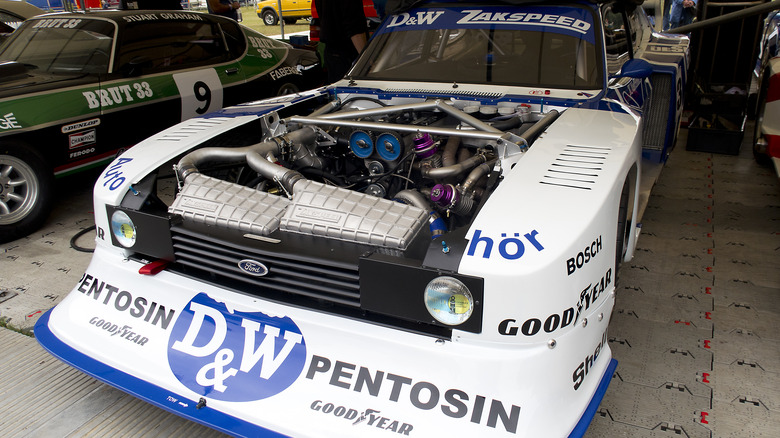The fuel crisis of the 1970s had caused Ford of Europe to shut down its in-house racing division. This set the stage for the Ford Zakspeed Capri to make its mark in Group 5 racing in Europe during the late 1970s and early 1980s. Group 5 guidelines allowed racing teams a great deal of latitude, as long as a few basic rules were observed. These included a limit on engine displacement and a passing resemblance to the production Capri (known as the «European Mustang») that it was based on.
This «flexible» attitude led to cars like the Ford Zakspeed Capri, a joint venture of Ford Europe and Zakspeed Racing. Their efforts produced a race car that was much closer to a Formula 1 competitor than it was to a production Capri available at the local Ford dealer. Engineers had lots of leeway in the engineering and design of these vehicles, and it shows on the Zakspeed Capri.
The Ford Zakspeed Capri was designed around a spaceframe with an integrated roll cage, made of aluminum alloy. The body work, which used Capri-looking doors, A- and C-pillars, and an actual Capri roof, was made mostly of strong but lightweight Kevlar. The original Capri grille was up front, while its taillights graced the rear. The rest of the Zakspeed Capri consisted of huge fenders to cover the massive BBS 10-inch wide 16″ front wheels and the 12.5″-wide 19″ rear wheels and tires, along with aerodynamic aids to keep it stuck to the track with maximum downforce.
The Ford Zakspeed Capri’s racing record

Michael Cole/Getty Images
The Ford Zakspeed Capri’s debut was midway through the 1978 season. The team chose to compete with a single car in Division 2. This was a notch below Division 1, where the top-dog Porsche 935s and BMW 320s roamed. With 380 horsepower from a twin-turbocharged, intercooled 1.4-liter engine, the Zakspeed Capri won four poles and one race. But reliability was a problem.
The 1979 season saw three Zakspeed cars entered, featuring engine upgrades which improved reliability — a single, larger turbo, combined with better intercoolers. They won the division 2 title, but came in behind the Division 1-leading Porsche, driven by Klaus Ludwig. Horsepower was up to 450 by the end of the season.
For 1980, the Ford Zakspeed Capris moved up to Division 1. Boring out the engine increased displacement to 1.7 liters, the twin turbos returned, and the aerodynamics were even more radical. The horsepower was now at 600, resulting in a top speed of over 180 MPH! Leaving nothing to chance, Ford and Zakspeed convinced champion Porsche driver Klaus Ludwig to break his contract and drive the Capri. Manfred Winklehock also drove. Unfortunately, controversies over the Zakspeed Capri’s aerodynamics caused Ludwig to lose points and Porsche won.
The 1981 season brought a two-pronged approach from the Ford Zakspeed Capris. Ludwig ran in Division 2, while Winklehock took on Division 1. Ludwig scored 11 wins out of 13 in Division 2, with Winklehock taking six wins in Division 1, denying Porsche the victory. The Ford Zakspeed Capris had won!
Whatever Happened To The Ford Zakspeed Capri?
In 1982, Group C replaced Group 5 as the top racing series. The Ford Zakspeed Capri would no longer be competitive. Both Ford and Zakspeed moved on to develop their own Group C racers, the Ford C100 and the Zakspeed C1/8. The Group 5 Division 1 Zakspeed Capris raced through the end of 1983, and that was it.
The Ford Zakspeed Capri was a pure racing car that owed little to its Capri production car origins. This was a result of the Group 5 regulations, which came very close to «anything goes.» These Group 5 cars looked just enough like their production-car siblings to create a rooting interest among their fans. As opposed to the Division 1 Porsche 935 or BMW 320, the Ford Zakspeed Capri may have been the farthest away from a production vehicle, as it did not use any substantial part of the Capri’s original structure, beyond its roof and roof pillars.
Some of the Ford Zakspeed Capris have been preserved and can sometimes be seen in vintage racing venues or when they occasionally pop up at auction. There were a total of six Zakspeed Capris produced, of which three appear to have survived. Compare this to the total of 1.9 million Ford (and failed brand Mercury) Capris that were sold around the world during its run from the 1969 through 1986 model years, although the European Capri was no longer sold in the U.S. after 1977.